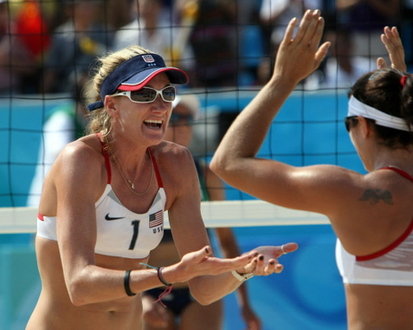| |||||||||||||||||||||||||||||||||||||||||||||||||||||||||||||||||||||||||
|
World champions Misty1 May-Treanor and Kerri Walsh undoubtedly2 have superb beach volleyball skills, but it is their eight-year history together and close friendship that they reckon is the magic ingredient in their partnership3.
Beach volleyball is rife4 with partner-swapping as players try to find the right combination between a tall powerful blocker to take the net and an athletic5 digger to play at the back. In a two-on-two game, though, that is not enough. If the off-court chemistry does not work between a pair, on-court results tend to show.
Brazilians Ana Paula Connelly and Larissa Franca were known to have a prickly relationship before they were thrown together for the Beijing Olympics when another player was injured. Their play improved by the game but was still not united or intuitive enough to get past the quarterfinals. "We talked forever, until 2, 3, 4 in the morning about life, volleyball, boyfriends, children, friends and family to get to know each other," said Ana Paula. "We knew the off-court relationship could help us on court. Now I realize that when she yells, she doesn't do it to make you feel bad but because she wants the best for you." May-Treanor and Walsh, who may break up after the Olympics to have families, said it had taken time to build up a sixth-sense about where the other one was on court and how they would move. "Trying to find the right chemistry is tough. We weren't at this level in the first year. You have to work through the ups and downs. Like in a marriage, when things don't go your way you don't split up, you work at it," May-Treanor said. Plenty of partners have not done that. Holly6 McPeak and Nancy Reno qualified7 for the 1996 Olympics but had such problems that they broke up for several months and only joined up again for the Games, where they came fifth. McPeak has been through several partners since, in search of chemistry. Latvia's Aleksandrs Samoilovs and Martins Plavins did much better than expected in Beijing but still plan to separate now. "It's hard to play together for five years. Aleksandrs is so different and it's hard always to be together," Plavins said. Others have no choice. The Chinese teams who made the women's semifinals said they did not know if they would stay together and that their future pairings would depend on their coaches. The alternative option is not to worry about trying to gel off-court but just to get on with life, as is the case with top-ranked US pair Todd Rogers and Phil Dalhausser. "We're both really chilled out, don't get stressed," said Dalhausser. "That's just kind of it but it works." Commenting on the final against China's Tian Jia and Wang Jie, May-Treanor said: "We have so much respect for the Chinese team. We've got to work our own game, watch some videos and practice hard. "We just have to focus on ourselves. We know the younger girls have a huge block and great defense8, so we're going to prepare for the battle out there," she added. Asked if she was ready to take the gold medal again, May-Treanor said: "Yes." Walsh said she is not familiar with the Chinese girls, but she found them to be "sweet and patient". "They are sweet and patient. They are very kind girls. They always smile," she said. With Tuesday's victory, the US duo now boasts a 107-match winning streak9. 点击  收听单词发音 收听单词发音
|
|||||||||||||||||||||||||||||||||||||||||||||||||||||||||||||||||||||||||
- 发表评论
-
- 最新评论 进入详细评论页>>




